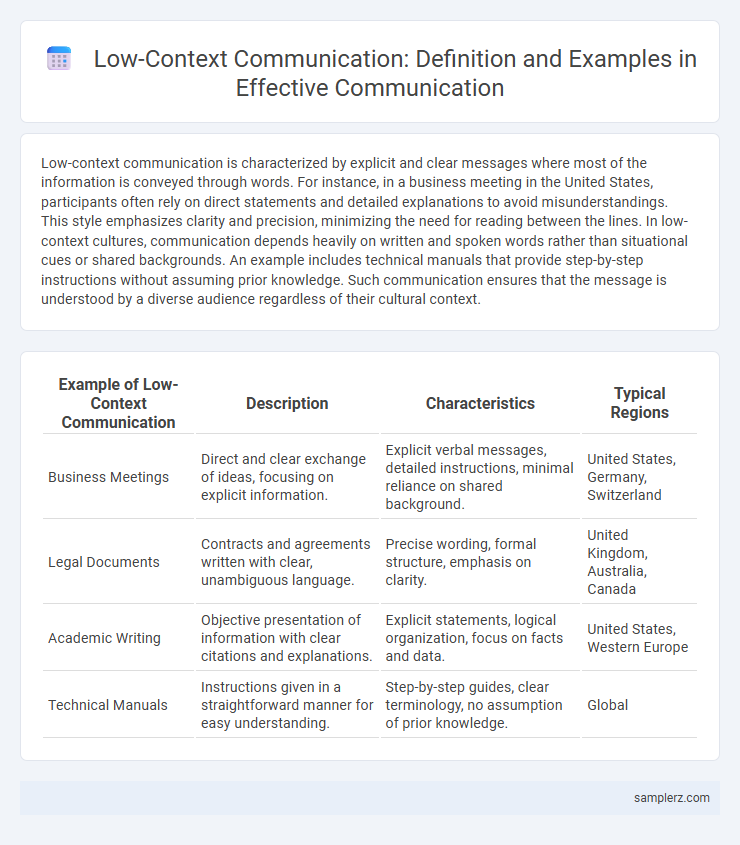Low-context communication is characterized by explicit and clear messages where most of the information is conveyed through words. For instance, in a business meeting in the United States, participants often rely on direct statements and detailed explanations to avoid misunderstandings. This style emphasizes clarity and precision, minimizing the need for reading between the lines. In low-context cultures, communication depends heavily on written and spoken words rather than situational cues or shared backgrounds. An example includes technical manuals that provide step-by-step instructions without assuming prior knowledge. Such communication ensures that the message is understood by a diverse audience regardless of their cultural context.
Table of Comparison
| Example of Low-Context Communication | Description | Characteristics | Typical Regions |
|---|---|---|---|
| Business Meetings | Direct and clear exchange of ideas, focusing on explicit information. | Explicit verbal messages, detailed instructions, minimal reliance on shared background. | United States, Germany, Switzerland |
| Legal Documents | Contracts and agreements written with clear, unambiguous language. | Precise wording, formal structure, emphasis on clarity. | United Kingdom, Australia, Canada |
| Academic Writing | Objective presentation of information with clear citations and explanations. | Explicit statements, logical organization, focus on facts and data. | United States, Western Europe |
| Technical Manuals | Instructions given in a straightforward manner for easy understanding. | Step-by-step guides, clear terminology, no assumption of prior knowledge. | Global |
Defining Low-Context Communication
Low-context communication relies on explicit, direct verbal messages where meaning is conveyed primarily through words rather than situational cues. It is common in cultures such as the United States and Germany, where clarity, precision, and detailed information are prioritized to avoid misunderstandings. This style emphasizes transparent expression and straightforward instructions, making it effective in legal, business, and technical communication settings.
Key Features of Low-Context Communication
Low-context communication relies heavily on explicit, clear, and direct messages where meanings are spelled out through words rather than situational cues. It emphasizes precise language, detailed instructions, and transparent information exchange, minimizing the role of nonverbal signals. This style is common in cultures like the United States and Germany, where clarity and straightforwardness are essential for effective communication.
Everyday Examples of Low-Context Communication
Everyday examples of low-context communication include written instructions, emails, and formal meetings where information is explicitly stated and detailed to avoid misunderstandings. In these interactions, clarity and directness are prioritized over relying on shared background or nonverbal cues. This style is common in professional environments and cultures like the United States and Germany, where explicit communication ensures efficient information transfer.
Low-Context Communication in the Workplace
Low-context communication in the workplace relies on clear, explicit messages where information is conveyed primarily through words rather than context or nonverbal cues. This style is common in multinational corporations where clarity and directness reduce misunderstandings among diverse teams. Employees benefit from precise instructions and transparent feedback, facilitating efficient collaboration and decision-making.
Low-Context Communication in Education Settings
In education settings, low-context communication involves explicit verbal instructions and detailed explanations, ensuring all students clearly understand expectations regardless of background. Classroom materials like syllabi, rubrics, and handouts provide concrete information, minimizing reliance on implied meanings or shared cultural cues. This approach promotes clarity, reduces misunderstandings, and supports diverse learner populations by prioritizing precise, direct communication.
Cross-Cultural Examples of Low-Context Communication
In cross-cultural communication, low-context communication is prevalent in countries like the United States, Germany, and Switzerland, where messages are explicit, direct, and rely less on nonverbal cues. Business negotiations in Germany emphasize clarity and precision, ensuring that contracts and agreements leave little room for ambiguity. This style contrasts with high-context cultures, where understanding depends heavily on shared experiences and implicit information.
Benefits of Low-Context Communication
Low-context communication emphasizes clear, explicit messages that reduce misunderstandings and enhance efficiency in diverse teams. This communication style supports faster decision-making as all necessary information is directly conveyed without relying on shared background or nonverbal cues. Organizations experience improved clarity and transparency, which fosters accountability and minimizes errors in cross-cultural collaborations.
Challenges of Low-Context Communication
Low-context communication challenges arise from its reliance on explicit verbal messages, often leading to misunderstandings in multicultural environments where nonverbal cues and shared context are lacking. This communication style can cause inefficiencies and frustration when interlocutors expect detailed explanations but fail to grasp implicit meanings and emotional subtleties. Organizations operating globally must address these issues by fostering clarity, patience, and cultural awareness to minimize misinterpretations and improve collaboration.
Low-Context Communication in Digital Environments
Low-context communication in digital environments relies heavily on explicit, clear messages conveyed through text, emails, or online chats, minimizing the need for shared background or nonverbal cues. Platforms like Slack and Zoom facilitate direct exchanges where precision and clarity are essential to avoid misunderstandings due to the absence of face-to-face interaction. This style is prevalent in global remote teams, where participants come from diverse cultural backgrounds and require straightforward, unambiguous communication to collaborate effectively.
Tips for Effective Low-Context Communication
Effective low-context communication relies on clear, direct language and explicit messages that leave little room for interpretation. Emphasize precise vocabulary, provide detailed explanations, and confirm understanding through feedback to prevent miscommunication. Using visual aids or written summaries can enhance clarity and ensure all parties receive consistent information.

example of low-context in communication Infographic
 samplerz.com
samplerz.com